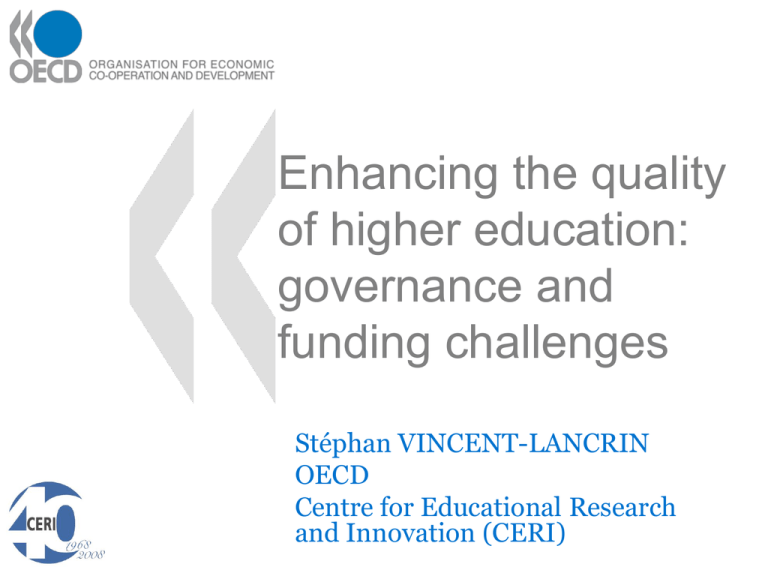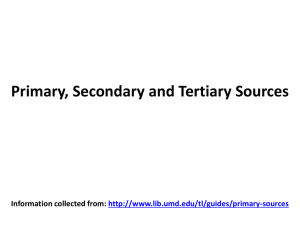Mr. Stephan Vincent
advertisement

Enhancing the quality of higher education: governance and funding challenges Stéphan VINCENT-LANCRIN OECD Centre for Educational Research and Innovation (CERI) Outline • Tertiary education and economic performance • Enhancing the quality of: – Teaching – Research • Funding and governance implications Tertiary education and economic performance • Labour productivity • Innovation in the economy – Researchers and R&D – Absorption of innovation • Lifelong learning – Absorption of innovation New demands of the modern economy • Technology-bias towards highly skilled people • Increasing need for non-routine cognitive skills in advanced economies – Interactive – analytical Mean task input as percentiles of the 1960 task distribution How the demand for skills has changed Economy-wide measures of routine and non-routine task input (US) Routine manual 65 60 Nonroutine manual 55 Routine cognitive 50 Nonroutine analytic 45 40 1960 1970 1980 Source: Levy and Murnane 1990 2002 Nonroutine interactive Missions of higher education • Teaching • Research • Community services • • • • Production of new knowledge Transmission of knowledge Transmission of critical thinking Maintaining of old knowledge (culture, scholarship, libraries) EDUCATION / TEACHING EU countries tend to invest less than OECD average as a % of GDP (2004) The US and Korea invest about twice as much in education per se as most EU countries (% GDP) (2004) Annual expenditures per student on tertiary education (Constant US dollars, PPPs) 100 133 137 120 122 112 112 112 111 139 139 125 114 141 146 147 140 126 115 120 138 140 170 163 167 158 160 174 180 167 200 182 220 202 244 Change in expenditures on tertiary education (1995-2003) 240 Household contribution to tertiary education expenditures (2003) 70% 60% 57% 60% 50% 39% 37% 35% 30%31% 40% 30% 20% 10% 3% 3% 4% 0% 0% 0% 0% 5% 5% 6% 6% 23% 19%19%19% 17% 14% 11%11%12% 7% 8% 9% The expansion in numbers may continue and put pressure on quality: projected tertiary enrolments in 2025 under recent trends (2005=100) Source: OECD, Higher Education 2030, Vol. 1 Demography (forthcoming) How much additional public budget (% of GDP) will be needed to keep current “quality” conditions in 2025 (scenario 2, no productivity enhancement, current cost-sharing) Evolution of student/staff ratio according to recent trends in access (if staff stay at 2004 level) Changes in the number of 25-44 tertiary graduates relative to the US Tertiary Educational Attainment of the 25-44 population 2005 and 2025 (trends of past 10 years) Quality of education • Teaching is the first and main function of Higher Education • BUT little incentives for teaching: bad teaching is often unnoticed, and good teaching, unrewarded Quality of education • Change the incentive structures – Reward and value good teaching as much as research – Assessment of tertiary education learning outcomes • Differentiated tertiary education sector – Avoid academic drift • Develop soft skills during first years of university – Implies better student/staff ratio for the undergraduate years (funding) – New pedagogies and productivity enhancements (e-learning?) • Internationalisation – Encourage outward and inward student mobility Quality of education • Autonomy and accountability – Lift administrative burdens of public accountancy – Autonomy to hire and to some extent set wages • Quality assurance mechanisms – Risks: costly and burdensome – Objective: should develop quality culture • Performance-based funding – Important to have agreed targets – Mix of input- and output-based funding works well • Importance of lifelong learning – Not necessarily in tertiary education – Examples: community colleges in the US RESEARCH Share of students enrolled in advanced research programmes (ISCED 6) (2005) Research « Public » research expenditures as a percentage of GDP (2005) Lisbon agenda target Number of (ISI) articles per million inhabitant Scientific articles per million inhabitants Relative public research productivity Public research as % of GDP Scientific articles per million inhabitants Relative public research productivity Public research as % of GDP Quality of research • Concentrate the funding? – A question of balance: project-based funding and block grants – Avoid short term funding and « research to the assessment » • Relocate the excellent research? – World class universities, mergers, centres of excellence – To be balanced against regional innovation • Avoid academic drift CONCLUSIONS Conclusion • Research is important, but education even more so • Funding is important: level and type of allocation – – – – More funding for tertiary education(new cost sharing?) Balance in funding mechanisms, based on inputs and outputs In research, be ready to « lose » money Competing with Harvard will be difficult… • But quality is not just about money – Education: innovation in teaching, focus on graduation and not just entry – Research: be ready to lose and waste money by funding controversial research and researchers • Internationalisation contributes to quality enhancement Stephan.Vincent-Lancrin@oecd.org THANK YOU www.oecd.org/edu/universityfutures



